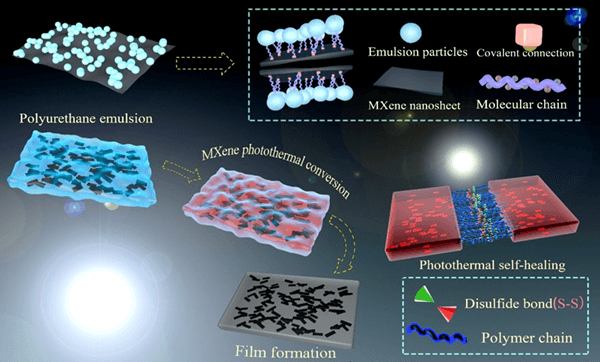 Open Access
Open Access
ARTICLE
Towards Solar-Driven Formation of Robust and Self-Healable Waterborne Polyurethane Containing Disulfide Bonds via in-situ Incorporation of 2D Titanium Carbide MXene
1 College of Materials Science & Engineering, Nanjing Tech University, Nanjing, 211816, China
2 Key Laboratory of Flexible Electronics (KLOFE) & Institute of Advanced Materials (IAM), Jiangsu National Synergetic Innovation Center for Advanced Materials (SICAM), Nanjing Tech University, Nanjing, 211816, China
* Corresponding Authors: Tingwei Wang. Email: ; Dongyu Cai. Email:
# These authors make equal contribution to this work
Journal of Renewable Materials 2023, 11(3), 1063-1076. https://doi.org/10.32604/jrm.2022.023011
Received 05 April 2022; Accepted 13 June 2022; Issue published 31 October 2022
Abstract
Waterborne polymers are vital for coating industry to reduce carbon emissions. However, formation of robust and self-healable films at ambient temperature remains a challenge owing to high energy cost of film formation process. This work reports a solar-driven film formation of waterborne polyurethanes (WPUs) containing disulfide bonds via in-situ incorporation of 2D titanium carbide (MXene) with ability to convert light to heat. Instead of directly mixed with WPUs, MXene is added to join the reaction with isocyanate-terminated pre-polymer before emulsification process. This approach not only prevents aggregation of MXene in water but stabilizes MXene against thermal degradation which is the key hurdle for mass production of MXene/WPU composites. More importantly, our results show that mechanical performance of WPU films under visible light (100 mW/cm2) is overwhelmingly competitive with that processed in oven. Furthermore, the existence of disulfide bonds in PU chains enables fast self-healing of micro-cracks under natural visible light which could vanish completely within 40 min. The fractured specimens were repaired under natural visible light for 2 h, and the self-healing efficiency of tensile strength and elongation at break reached over 94.00%.Graphic Abstract

Keywords
Cite This Article
 Copyright © 2023 The Author(s). Published by Tech Science Press.
Copyright © 2023 The Author(s). Published by Tech Science Press.This work is licensed under a Creative Commons Attribution 4.0 International License , which permits unrestricted use, distribution, and reproduction in any medium, provided the original work is properly cited.


 Submit a Paper
Submit a Paper Propose a Special lssue
Propose a Special lssue View Full Text
View Full Text Download PDF
Download PDF Downloads
Downloads
 Citation Tools
Citation Tools